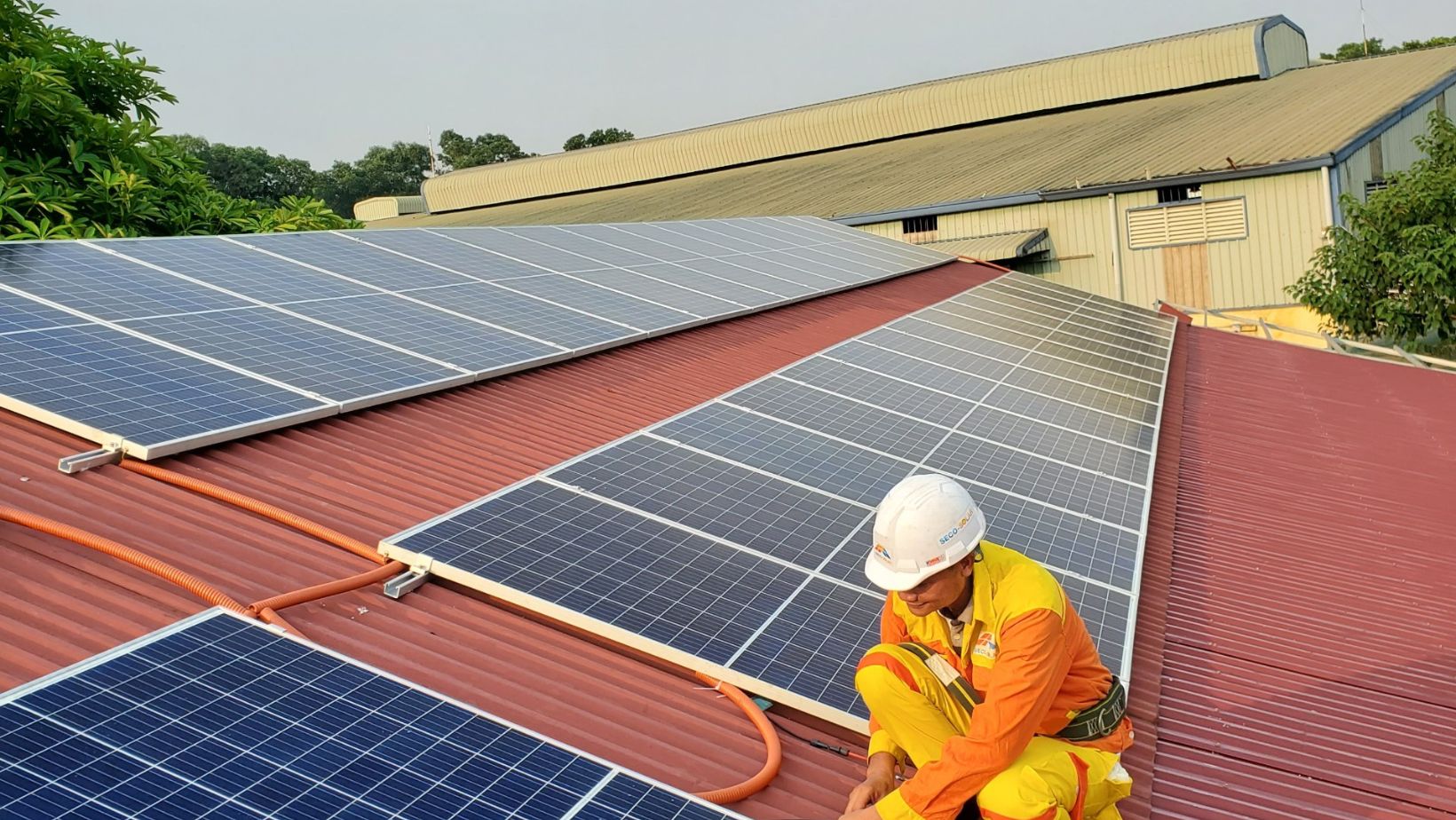Can Solar Panels Alone Power Your Whole House?

Contents
ToggleSolar panels have become a familiar sight on rooftops across the country — a symbol of clean, renewable, and self-sufficient energy. But one question remains for many homeowners: can solar panels alone truly power your entire house?
The answer depends on multiple factors — from how much energy your household uses to whether you’ve paired your system with a whole home battery backup.
The Growing Appeal of Solar Energy
As utility rates rise and extreme weather causes more frequent blackouts, homeowners are increasingly turning to solar power for independence and stability. A well-designed solar system can significantly reduce your reliance on the grid and even eliminate your monthly electricity bill under the right conditions.
However, most people are surprised to learn that solar panels on their own can’t always keep your home running 24/7 — especially when the sun isn’t shining. To unlock true energy independence, solar needs a reliable partner: a whole home battery backup system.
Understanding How Solar Panels Work
Solar panels capture sunlight and convert it into electricity. During the day, your panels generate direct current (DC) power, which your inverter converts into alternating current (AC) — the type of electricity your home uses.
When your panels produce more electricity than you need, the extra energy can either:
- Be sent back to the grid (if your utility allows net metering), or
- Be stored in a home battery backup system for later use.
The problem arises when the sun goes down or during cloudy, stormy weather. Without storage, your panels stop producing energy at night, and your home must rely on grid electricity — or go dark if there’s an outage.
That’s why most “solar-only” homes still depend on utility power for part of the day. To power your entire home continuously, you need a way to store energy for times when solar production drops.
The Limitation of Solar Panels Alone
Solar power generation follows the sun’s schedule — not yours. While most households use the most energy in the evenings, solar panels produce their maximum output in the afternoon.

This timing mismatch means even a large solar array can’t provide consistent power without storage. Let’s look at a simple example:
- Daytime: Your 8 kW solar system may generate more energy than you use while you’re at work. Without batteries, that extra power goes back to the grid, often at a lower credit rate than what you pay to buy electricity later.
- Nighttime: When you come home and start cooking, running the AC, and using electronics, your panels produce nothing. You’re now fully reliant on the grid.
In short, solar panels alone can reduce your electricity bills and carbon footprint — but they can’t make your home fully self-sufficient. That’s where a whole home battery backup comes in.
How Whole Home Battery Backup Complements Solar
A whole home battery backup system stores the surplus electricity your panels produce during the day and delivers it back to your home when solar generation slows down or stops.
Here’s how it works in a typical setup:
- Daytime charging: Your solar panels generate electricity, which first powers your home. Excess energy is automatically routed to your battery.
- Nighttime usage: After sunset, your whole home battery backup supplies stored energy to run your lights, appliances, and HVAC system.
- During outages: If the grid fails, your battery instantly takes over — no noise, no fuel, no manual start-up.
This seamless transition ensures that your home remains powered 24/7, even during storms or extended blackouts.
How Much Solar Power Does It Take to Run a Whole House?
The amount of solar energy you need depends on your household’s energy usage and location. The average U.S. home consumes about 30 kWh of electricity per day. A typical 1 kW of solar capacity generates around 4–5 kWh per day, depending on sunlight exposure.
That means an average home would need 6–8 kW of solar panels — roughly 15 to 25 panels — to offset 100% of its daily usage.
But here’s the key: even if your panels generate enough electricity over 24 hours, that power isn’t available when you need it most unless it’s stored. Pairing your system with a whole home battery backup bridges that gap, turning “daytime-only” solar into a reliable, around-the-clock power solution.
The Role of Net Metering — and Its Limits
Net metering is a policy that allows homeowners to send excess solar energy back to the grid in exchange for credits. These credits offset the power you draw at night.
While this can reduce your bills, it’s not a true backup plan. During a blackout, your grid-tied solar system shuts down automatically to protect utility workers. That means you’ll lose power even if the sun is shining and your panels are working perfectly.
A whole home battery backup system solves this by keeping your solar array operational during outages. It isolates your home from the grid (“islanding”) so your solar panels and batteries continue to provide electricity safely.
In states where utilities are reducing net metering compensation (like California’s NEM 3.0), storage has become even more valuable. Instead of selling excess energy back to the grid at low rates, you can store it and use it later — increasing your system’s financial return.
Advantages of Combining Solar Panels with Battery Backup
1. 24/7 Power Reliability
With solar alone, your power production stops at sunset. With whole home battery backup, your home stays powered through the night or during grid failures.
2. Lower Electricity Costs
Batteries let you store excess solar power or cheap off-peak electricity, avoiding high utility rates during peak demand hours.
3. Energy Independence
A solar + battery setup lets you rely less on your utility company. In some cases, you can even go completely off-grid — especially if you add a generator or expand your storage capacity.
4. Clean, Quiet Backup Power
Unlike gas-powered generators, home battery backup systems produce no noise or fumes. They operate silently and safely inside or outside your home.
5. Long-Term Savings and Incentives
The federal Investment Tax Credit (ITC) offers a 30% tax credit on the cost of eligible solar and battery installations. Some states also provide rebates or performance-based incentives that make the combination even more affordable.
How Long Can a Home Battery Backup Run Your House?
Runtime depends on your system’s capacity and your energy use.
- A 10 kWh battery can typically power essentials — refrigerator, lights, Wi-Fi, and small electronics — for 12–24 hours.
- A 30 kWh system can handle partial or full-home loads for a day or two.
- Pairing multiple batteries allows for extended protection or full off-grid operation.
If your solar panels continue charging the battery during the day, your system can essentially sustain itself indefinitely — a perfect synergy between renewable generation and reliable storage.
What About Maintenance and Lifespan?
One major advantage of whole home battery backup systems is low maintenance. Unlike fuel-powered generators that require oil changes, refueling, and noise control, batteries have no moving parts and minimal upkeep.
Most modern lithium-ion or LiFePO₄ batteries last 10–15 years with warranties guaranteeing 60–80% capacity retention over time. Inverters and control systems may need periodic updates, but overall maintenance is minimal.
Solar panels themselves last 25 years or more, meaning your combined system can serve you reliably for decades.
Cost Considerations
A solar system alone can cost anywhere from $10,000 to $20,000, depending on size and region. Adding whole home battery backup typically adds $8,000–$15,000, depending on capacity and integration.
However, the 30% federal tax credit and various state-level incentives can significantly lower the total price. Over time, the savings from reduced electricity bills and the peace of mind during blackouts make the investment worthwhile.
Many homeowners also find that properties with solar + battery systems have higher resale value, as buyers increasingly look for energy-efficient and resilient homes.
The Future: Smarter, Cleaner Energy
The combination of solar and whole home battery backup represents the future of residential power. With smart panels, AI-driven energy management, and bi-directional EV chargers, homes are becoming miniature power plants — generating, storing, and managing their own electricity.
Utilities are adapting too. In the coming years, grid-interactive homes may even sell stored power back to utilities during peak demand, turning everyday homeowners into active participants in the energy ecosystem.
Conclusion
So, can solar panels alone power your entire house? Technically, yes — but only when the sun is shining and your energy use aligns perfectly with production. For true 24/7 reliability and independence, pairing solar panels with a whole home battery backup is the key.
By storing your own energy, you can keep your home running smoothly through any outage, reduce your bills, and take one major step toward a cleaner, more resilient energy future.
What's Your Reaction?
Gregory is a website manager who loves reading books, learning languages and traveling. He's always been fascinated by different cultures, and has spent years studying different languages in order to be able to communicate with people from all over the world. When he's not working or traveling, he enjoys relaxing at home with a good book.



